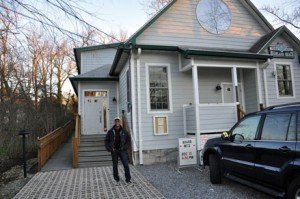+ By Sydney Petty + Photos by Karen Davies
The Annapolis Neck Peninsula is an alluring area, full of the natural beauty of the Chesapeake Bay and its tributaries. It is also rich in history, as its residents well know. How a community of eminent African Americans settled in the area during the segregated “Jim Crow” era after the Civil War makes for an interesting story.
Highland Beach, for example, incorporated in 1922—and the only incorporated town in Anne Arundel County outside of Annapolis—is a place of singular distinction. This famous community of prominent African American families began one fortuitous day in 1892, when Frederick Douglass’ son Charles, his wife Laura, and their son Haley visited the Bay Ridge Resort and Amusement Park, or the “Queen Resort of The Chesapeake,” as the now-residential community of Bay Ridge was known at that time.
 Mrs. Douglass, taken with the place, asked if there was housing nearby where she could board. In that time of segregation, she was directed to a bay-front farm adjoining Bay Ridge owned by the Brashears, a family of African American farmers. The Brashears agreed to sell the Douglasses a forty-acre parcel of land, which they quickly set about turning into a summer vacation retreat for family and friends.
Mrs. Douglass, taken with the place, asked if there was housing nearby where she could board. In that time of segregation, she was directed to a bay-front farm adjoining Bay Ridge owned by the Brashears, a family of African American farmers. The Brashears agreed to sell the Douglasses a forty-acre parcel of land, which they quickly set about turning into a summer vacation retreat for family and friends.
Douglass built himself a house there, and another, Twin Oaks—for his famous abolitionist father—with a balcony, “where he planned to sit and gaze out over the Chesapeake Bay to the Eastern Shore where he had been born a slave.” Unfortunately, Frederick Douglass did not live to see the house finished.
This “isolated sanctuary,” as described by current Highland Beach mayor Bill Sanders, became the cherished summer vacation spot for a close-knit community of eminent African American doctors, writers, scientists, and educators from the Washington, DC and Baltimore areas—people such as Booker T. Washington, Harriet Tubman, Robert Weaver, Paul Robeson, Alex Haley, W. E. B. Dubois, Langston Hughes, and Arthur Ashe. Over the years, residents played rousing games of tennis on seven courts, held dances, built and launched boats onto the bay, fished, crabbed, and told stories at night around blazing campfires.
The street names of Highland Beach—names such as Dunbar, Crummell, Henson, Augusta, Douglass, Langston, and Washington—honor distinguished African Americans such as writer Paul Lawrence Dunbar and explorer Matthew Henson, who, after six attempts over 18 years with Robert Peary, was among the first people to reach the North Pole.
 The settlement grew to become an enclave of sixty beach cottages, many of which, like its neighboring bay-front communities, made the transition into lovely year-round homes. Twin Oaks is now known as the Frederick Douglass Museum and Cultural Center, and residents are duly proud of their town’s recent green initiatives, led by Mayor Sanders and his wife, Zora Lathan, both prominent ecologists (he is former director of the U.S. Environmental Protection Agency’s National Center for Environmental Research, she is director of the Chesapeake Ecology Center and was formerly with the National Audubon Society).
The settlement grew to become an enclave of sixty beach cottages, many of which, like its neighboring bay-front communities, made the transition into lovely year-round homes. Twin Oaks is now known as the Frederick Douglass Museum and Cultural Center, and residents are duly proud of their town’s recent green initiatives, led by Mayor Sanders and his wife, Zora Lathan, both prominent ecologists (he is former director of the U.S. Environmental Protection Agency’s National Center for Environmental Research, she is director of the Chesapeake Ecology Center and was formerly with the National Audubon Society).
“When we first visited here in 1998,” says Sanders, “it was so nice, we asked about homes for sale, and were told that most of them are passed down through families. But we got lucky—someone told us about one that was on the market.”
The new Town Hall of Highland Beach, completed in 2006, was the second building in the county to achieve the U.S. Green Building Council’s LEED platinum certification—the first being the world-famous Chesapeake Bay Foundation headquarters building across Black Walnut Creek in the Bay Ridge community. It achieved that premier status with exceptional insulation, a high-performing HVAC system, and a vegetated green roof and rain gardens that capture and contain all rainwater on-site, preventing runoff into nearby Oyster Creek and the Chesapeake Bay. Solar panels on the roof allow the town to produce energy.
Other African American beach areas that came into being soon after Highland Beach include neighboring Venice Beach, settled in 1922, Oyster Harbor, Bay Highlands, and nearby Arundel-on-the Bay, a community of 345 homes that attracted affluent African American families beginning in the 1940s. Residents included Aris T. Allen Jr., the son of husband and wife doctors Aris T. and Faye Allen (Dr. Aris Allen was also the first African American chair of the Maryland Republican party), and former Baltimore Mayor Kurt Schmoke.
At its height, African American ownership of land in the Annapolis Neck totaled 246 acres. This included the famous Carr’s Beach, Sparrows Beach, and Bembe Beach, all adjacent to the community now known as The Villages of Chesapeake Harbor.
Carr’s Beach started as a public beach in 1929, and people paid a ten-cent admission fee to swim, ride on a Ferris wheel, enjoy pony rides, and see the Chitlin’ Circuit musical acts of the day perform in an open-air pavilion. People by the hundreds danced to the beat of such luminaries as Fats Domino, Ray Charles, Duke Ellington, Count Basie, Stevie Wonder, Little Richard, The Coasters, Sarah Vaughan, Billie Holiday, and Aretha Franklin.
Sadly, rapid redevelopment of the area in the 1960s led to the demise of Carr’s Beach. Its last concert, in 1974, featured Baltimore’s own Frank Zappa. But Carr’s Beach lives on in the memories of those lucky enough to have enjoyed it in its heyday.
No matter the odds, humans strive for happiness. Charles Douglass, who served in the Union army during the Civil War, inherited his father’s tenacity and seized the opportunity to create a home here. It gave rise to a community rich in character, culture, and history. █













